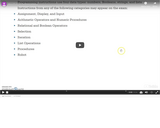
Interactive video reviewing essential knowledge for the AP CS Exam.
- Subject:
- Applied Science
- Computer Science
- Material Type:
- Interactive
- Provider:
- Michigan Virtual
- Date Added:
- 12/11/2018

Interactive video reviewing essential knowledge for the AP CS Exam.
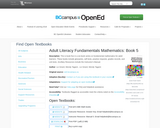
: Fundamental mathematics for adult learners. Book 5 includes a Table of Contents, Glossary, Grades Records, Self Tests, Practice Tests and Unit Tests. Ancillary Resources include the Instructor's Manual. This is 1 of a series of 6 books in the ABE Math collection.
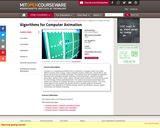
In-depth study of an active research topic in computer graphics. Topics change each term. Readings from the literature, student presentations, short assignments, and a programming project. Animation is a compelling and effective form of expression; it engages viewers and makes difficult concepts easier to grasp. Today's animation industry creates films, special effects, and games with stunning visual detail and quality. This graduate class will investigate the algorithms that make these animations possible: keyframing, inverse kinematics, physical simulation, optimization, optimal control, motion capture, and data-driven methods. Our study will also reveal the shortcomings of these sophisticated tools. The students will propose improvements and explore new methods for computer animation in semester-long research projects. The course should appeal to both students with general interest in computer graphics and students interested in new applications of machine learning, robotics, biomechanics, physics, applied mathematics and scientific computing.
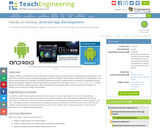
Students develop an app for an Android device that utilizes its built-in internal sensors, specifically the accelerometer. The goal of this activity is to teach programming design and skills using MIT's App Inventor software (free to download from the Internet) as the vehicle for learning. The activity should be exciting for students who are interested in applying what they learn to writing other applications for Android devices. Students learn the steps of the engineering design process as they identify the problem, develop solutions, select and implement a possible solution, test the solution and redesign, as needed, to accomplish the design requirements.
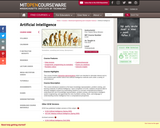
This course introduces students to the basic knowledge representation, problem solving, and learning methods of artificial intelligence. Upon completion of 6.034, students should be able to develop intelligent systems by assembling solutions to concrete computational problems, understand the role of knowledge representation, problem solving, and learning in intelligent-system engineering, and appreciate the role of problem solving, vision, and language in understanding human intelligence from a computational perspective.

Tony Sarg was a puppeteer and marionette master who invented the first, larger than life, helium balloons for the annual Macy’s Thanksgiving Day Parade. The resource includes a lesson plan/book card, a design challenge, and copy of a design thinking journal that provide guidance on using the book to inspire students' curiosity for design thinking. Maker Challenges include: (1) Dash/Sphero: Develop a Macy’s Day Parade route using tape on the ground with a partner. Then, switch routes with another group and program the robot of your choice to navigate the parade route using code. (2) Ozobot: Develop a synchronized dance routine for both Ozobots for the stage of the Macy’s day parade using https://ozoblockly.com/editor (3) Create a moveable puppet that will be featured in the Macy’s Day Parade.
A document is included in the resources folder that lists the complete standards-alignment for this book activity.
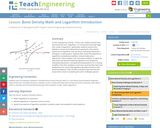
In their reading from activity 1 of this unit, students should have discovered the term "logarithm." It is at this point that they begin their study of logarithms. Specifically, students examine the definition, history and relationship to exponents; they rewrite exponents as logarithms and vice versa, evaluating expressions, solving for a missing piece. Students then study the properties of logarithms (multiplication/addition, division/subtraction, exponents). They complete a set of practice problems to apply the skills they have learned (rewriting logarithms and exponents, evaluating expressions, solving/examining equations for a missing variable.) Then they complete a short quiz covering what they have studied thus far concerning logarithms (problems similar to the practice problems). They consider how what they have learned moves them closer to answering the unit's challenge question.
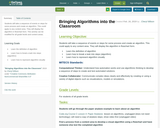
Students will take a sequence of events or steps for some process and create an algorithm. This could apply to any content area. They will display the algorithm in flowchart form. This activity can be modified for all grade levels and content areas.
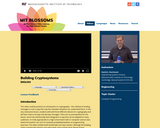
This video module presents an introduction to cryptography - the method of sending messages in such a way that only the intended recipients can understand them. In this very interactive lesson, students will build three different devices for cryptography and will learn how to encrypt and decrypt messages. There are no prerequisites for this lesson, and it has intentionally been designed in a way that can be adapted to many audiences. It is fully appropriate in a high school level math or computer science class where the teacher can use it to motivate probability/statistics or programming exercises. nteractive lesson, students will learn to build the cryptography devices and will learn how to send and ''crack'' secret messages.
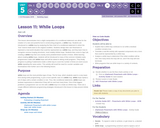
This lesson demonstrates how a slight manipulation of a conditional statement can allow for the creation of a new and powerful tool in constructing programs, a **while** loop. Students are introduced to a **while** loop by analyzing the flow chart of a conditional statement in which the "true" branch leads back to the original condition. Students design their own flowcharts to represent a real-world situation that could be represented as a **while** loop, and they learn how to recognize common looping structures, most notably infinite loops. Students then move to App Lab, creating a **while** loop that runs exactly some predetermined number of times. While learning about creating **while** loops, students will be introduced to many of the common mistakes early programmers make with **while** loops and will be asked to debug small programs. They finally progress to putting if statements inside a while loop to count the number of times an event occurs **while** repeating the same action. This activity will recall the need for counter variables and foreshadows their further use in the following lesson.
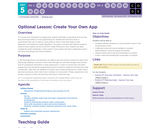
To conclude their introduction to programming, students will design an app based off of one they have previously worked on in the programming unit. Students will choose the kinds of improvements they wish to make to a past project in order to show their ability to make abstractions and implement complex algorithms. The project concludes with reflection questions similar to those students will see on the AP® Create Performance Task. Students can either complete the project individually or with a partner. Every student will need a collaborative partner with whom they will give and receive feedback.
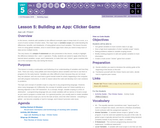
In this lesson, students add variables to two different exemplar apps to keep track of a score, or a count of some number of button clicks. The major topic is **variable scope** and understanding the differences, benefits, and drawbacks, of using global versus local variables. This lesson focuses more on using global variables, since in event-driven apps that’s what you need to keep track of data across multiple events.
The very basics of a **simple if statement** are also presented in this lesson, mostly to highlight the difference between the = and == operators. Finally, students are asked to apply what they’ve learned about variables, scope, and if statements, to make their own “clicker” game modeled after one of the exemplars they saw during the lesson.
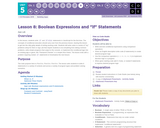
In this lesson, students write `if` and `if-else` statements in JavaScript for the first time. The concepts of conditional execution should carry over from the previous lesson, leaving this lesson to get into the nitty gritty details of writing working code. Students will write code in a series of "toy" problems setup for them in App Lab that require students to do everything from debug common problems, write simple programs that output to the console, or implement the conditional logic into an existing app or game, like "Password Checker" or a simple Dice Game. The lesson ends with a problem requiring nested `if` statements to foreshadow the next lesson.
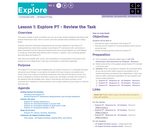
This lesson contains a series of activities you can use to help students familiarize themselves with Explore Performance Task, how it is scored, and some example tasks provided by the College Board.
Students review the Submission Requirements and Scoring Guidelines for the Explore PT. Subsequently they review three example scored Explore PT submissions with commentary to better understand how the Submission Requirements and Scoring Guidelines are used together. In a wrap-up conversation they identify a piece of advice, a "gotcha", and a remaining question they have about the Explore PT.
Note: Most the exemplar task, scores, and commentary on scoring shared in this lesson come directly from the College Board. Code.org's commentary is noted where applicable.
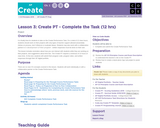
It is finally time for students to take on the Create Performance Task. For a total of 12 class hours, students should work on their projects with only types of teacher support allowed (essentially: Advise on process, don’t influence or evaluate ideas). Students may also work with a collaborative partner in *in development of their program* - written responses must be done on their own.
The lesson includes reminders about how you can interact with students while they are working on their projects, and suggestions about time line. The Create PT requires a minimum of 12 hours of class time. At the end, students will submit their program code, program video, and written responses through their AP digital portfolio.

In this kickoff to the Data Unit, students begin thinking about how data is collected and what can be learned from it. To begin the lesson, students will take a short online quiz that supposedly determines something interesting or funny about their personality. Afterwards they will brainstorm other sources of data in the world around them, leading to a discussion of how that data is collected. This discussion motivates the introduction of the Class Data Tracker project that will run through the second half of this unit. Students will take the survey for the first time and be shown what the results will look like. To close the class, students will make predictions of what they will find when all the data has been collected in a couple weeks.
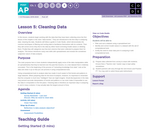
In this lesson, students begin working with the data that they have been collecting since the first lesson of the chapter in the class "data tracker." They are introduced to the first step in analyzing data: cleaning the data. Students will follow a guide in Code Studio, which demonstrates the common techniques of filtering and sorting data to familiarize themselves with its contents. Then they will correct errors they find in the data by either hand-correcting invalid values or deleting them. Finally they will categorize any free-text columns that were collected to prepare them for analysis. This lesson introduces many new skills with spreadsheets and reveals the sometimes subjective nature of data analysis.
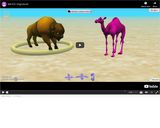
Interactive video showing new ways to change object colors in Alice.
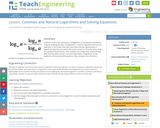
Students continue an examination of logarithms in the Research and Revise stage by studying two types of logarithms—common logarithms and natural logarithm. In this study, they take notes about the two special types of logarithms, why they are useful, and how to convert to these forms by using the change of base formula. Then students see how these types of logarithms can be applied to solve exponential equations. They compute a set of practice problems and apply the skills learned in class.

Interactive video will present number base systems.